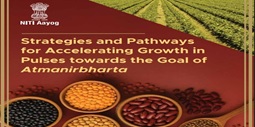21 September, 2025
Report on “Strategies and Pathways for Accelerating Pulses Development Towards Self-Reliance”
Fri 05 Sep, 2025
Context
- NITI Aayog released the report titled “Strategies and Pathways for Accelerating Pulses Development Towards Self-Reliance.”
Introduction :
- Pulses, which play a vital role in India’s food security and nutrition, are a crucial sector to achieve the goal of self-reliance.
- The report focuses on strategies and policy recommendations to strengthen pulses production, processing, and supply chains, aiming to reduce import dependency and boost domestic output.
- The report presentation was given by Dr. Neelam Patel, Senior Adviser (Agriculture Technology Division), NITI Aayog.
Objective of the Report
- To make India self-reliant in pulses production.
- Achieve self-sufficiency by 2030 and double production by 2047.
Current Status and Progress
Production and Imports
- In 2015-16, pulses production was 16.35 million tonnes (MT), leading to an import requirement of 6 MT.
- By 2022-23, production increased by 59.4% to 26.06 MT, with 38% productivity growth. Import dependence reduced from 29% to 10.4%.
Regional Contribution
- Madhya Pradesh, Maharashtra, and Rajasthan contribute ~55% of total production.
- The top 10 states account for more than 91% of national production.
Agro-climatic Advantage
- India’s diverse climate is suitable for cultivating 12 pulse crops during Kharif, Rabi, and Summer seasons.
- ~80% of pulses production depends on rain-fed areas, making it vulnerable to climate risks.
Key Strategies
The report suggests two main pillars: Horizontal Expansion and Vertical Expansion.
1. Horizontal Expansion (Increase in Area)
- Use of fallow lands: Promote pulse cultivation in rice fallow and underutilized lands with high-yielding varieties and inter-cropping.
- Crop-wise clustering: Cluster-based approach like “One Block-One Seed Village” model.
- 111 High-Potential Districts: Special focus on districts contributing 75% of national production.
- Area retention and diversification: Balance pulse farming with other crops.
2. Vertical Expansion (Increase in Yield)
- Improved varieties & hybrids: Develop and distribute high-yield, disease-resistant seeds.
- Seed treatment & quality: Emphasis on seed treatment kits and quality assurance.
Modern Agricultural Practices
- Scientific & timely sowing.
- Integrated nutrient, pest, weed, and water management.
- Technology interventions: Use of drones, sensors, and AI-based tools.
- Value addition: Strengthening processing units and storage infrastructure.
Farmer Empowerment
- FPOs (Farmer Producer Organizations): Promote collective farming and better market access.
- Women Participation: Training and support to rural women.
- Primary Survey: Insights from 885 farmers across 5 key states (Rajasthan, Madhya Pradesh, Gujarat, Andhra Pradesh, Karnataka).
Mission on Self-Reliance in Pulses (2025-26)
- Announcement: Union Budget 2025-26.
- Duration: 6 years (2025–2031).
- Focus: Tur (Arhar), Black Gram (Urad), and Lentil (Masoor).
- Goal: Reduce import dependency and strengthen domestic supply.
Projected Outcomes
Production Estimates
- By 2030: 30.59 MT (base estimate) → 48.44 MT (with strategy).
- By 2047: 45.79 MT (base estimate) → 63.64 MT (with strategy).
- ~20.10 MT additional growth possible with focused strategy implementation.
Other Benefits
- Reduced import dependency.
- Improved nutrition security with higher protein availability.
- Increased farmer income through better market opportunities & value addition.
- Environmental benefits through soil health improvement and climate-resilient farming.
Key Recommendations of the Report
- Land expansion: Use rice fallow lands and underutilized areas.
- High-quality seeds: Strengthen seed distribution and treatment kits.
- Cluster-based approach: Focus on 111 high-potential districts.
- FPO Model: Promote collective farming via “One Block-One Seed Village.”
- Climate adaptation: Develop drought-tolerant varieties and sustainable practices.
- Data-driven policies: Use monitoring and decision-support systems.
-
Export promotion: Enhance exports by meeting global quality standards.
NITI Aayog
- Full Form: National Institution for Transforming India.
- Headquarters: New Delhi.
Objectives
- Formulate strategic policies and programs for India’s development.
- Promote cooperative federalism between Centre and States.
- Provide technical and strategic advice for policy implementation.
- Support achievement of SDGs.
- Encourage innovation, entrepreneurship, and technology.
Structure
- Chairperson: Prime Minister of India (Currently Narendra Modi).
- Vice Chairperson: Executive head of NITI Aayog (Currently Suman Bery).
- Members: Full-time and part-time members, including experts (e.g., Dr. V.K. Saraswat, Dr. Arvind Virmani).
- CEO: Manages daily functions (Currently B.V.R. Subrahmanyam).
- Governing Council: Includes all state Chief Ministers, UT Lieutenant Governors, and senior Union Ministers.
Key Functions
- Developed India @2047: Strategic roadmap to make India a developed nation by 2047.
- Suggest policy reforms in sectors like MSMEs, digital transformation, and sustainable development.
- Frame policies in health, education, agriculture, infrastructure, etc.
- Collaborate with states to implement development projects.
- Promote data-driven policy formulation through digital tools and research.
Major Initiatives
- Aspirational Districts Programme – holistic development of backward districts.
- Atal Innovation Mission – boost innovation and startups.
- Digital India & Startup India – promote digital transformation & entrepreneurship.
- Policy Dialogues – platform for Centre–State policy discussions.
- SDG India Index – measure states’ progress towards SDGs.


















